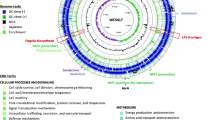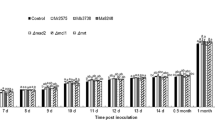Abstract
During studies on internal plant colonization by rhizosphere bacteria and endophytic bacteria over several years, we frequently observed lack of growth of rifampicin-resistant mutants (rif+) on tryptic soy agar amended with rifampicin (RTSA). Following seed treatment of cucumber with 6 species of rif+ rhizosphere bacteria in one experiment, all strains were recoverable on RTSA when external root colonization was monitored. Following trituration of surface-disinfested roots, only one strain grew directly on RTSA; however colonies isolated on tryptic soy agar (TSA) grew within 18 h after transfer to RTSA. We term this temporary loss of the antibiotic-resistant phenotype ‘antibiotic masking’. Antibiotic masking was also observed with isolation of 7 rif+ endophytic bacterial strains from inside stems of cotton and with isolation of mutants of bacterial endophytes resistant to polymyxin B sulfate from cotton plants. Rifampicin-masking was not accounted for in vitro by inhibitory compounds from cotton plant extracts, by bacterial growth on low nutrient agar, or by competition with other bacteria. Collectively, these results suggest that expression of antibiotic-resistance may be altered in planta, although causes for this antibiotic-masking remain to be elucidated, methods for quantifying internal plant colonization by rif+ bacteria should account for this possibility. ei]Section editor: R O D Dixon
Similar content being viewed by others
References
Chen C, Bauske E M, Musson G, Rodríguez-Kábana R and Kloepper J W 1995 Biological control of fusarium wilt on cotton by use of endophytic bacteria. Biol. Control 5, 83–91.
Compeau G, Al-Achi B J, Platsouka E and Levy S B 1988 Survival or rifampin-resistant mutants ofPseudomonas fluorescens andPseudomonas putida in soil systems. Appl. Environ. Microbiol. 54, 2432–2438.
Gagné S, Richard C and Antoun H 1989 Effet des bactéries endoracinaires glaçogè sur la résistance de la luzerne au gel. Phytoprotection 70, 63–73.
Gardner J M, Chandler J L and Feldman A W 1984 Growth promotion and inhibition by antibiotic-producing fluorescent pseudomonads on citrus roots. Plant and Soil 77, 103–113.
Gardner J M, Chandler J L and Feldman A W 1985 Growth responses and vascular plugging of citrus inoculated with bacteria and xylem-resident bacteria. Plant and Soil 86, 333–345.
Jacobs M J, Bugbee W M and Gabrielson D A 1985 Enumeration, location, and characterization of endophytic bacteria within sugar beet roots. Can. J. Bot. 63, 1262–1265.
Kloepper J W, Schroth M N and Miller T D 1980 Effects of rhizosphere colonization by plant growth-promoting rhizobacteria on potato plant development and yield. Phytopathology 70, 1078–1082.
Kloepper J W and Beauchamp C J 1992 A review of issues related to measuring colonization of plant roots by bacteria. Can. J. Microbiol. 38, 1219–1232.
Lalande R, Bissonnette N, Coutlée D and Antoun H 1989 Identification of rhizobacteria from maize and determination of their plant-growth promoting potential. Plant and Soil 115, 7–11.
Loper J E and Schroth M N 1986 Influence of bacterial sources of indole-3-acetic acid on roots elongation of sugar beet. Phytopathology 76, 386–389.
Lu S and Chen Y 1989 Preliminary studies on the main groups of microorganisms colonizing the vascular system of cotton plants and their population dynamics. Acta Agric. Univ. Pekinensis 15, 326–329.
McInroy J A, Wei G, Musson G and Kloepper J W 1992 Evidence for possible masking of rifampicin-resistance phenotype of marked bacteria in planta. Phytopathology 82, 1177.
Misaghi J J and Donndelinger C R 1990 Endophytic bacteria in symptom-free cotton plants. Phytopathology 80, 808–811.
Pankhurst C E 1977 Symbiotic effectiveness and antibiotic-mutants of fast- and slow-growing strains ofRhizobium nodulatingLotus species. Can. J. Microbiol. 23, 1026–1033.
Rennie R J, deFreitas J R, Ruschel A P and Vose P B 1982 Isolation of identification of N2-fixing bacteria associated with sugar cane (Saccharum sp.). Can. J. Microbiol. 28, 462–467.
VanPeer R, Punte H L M, deWeger L A and Schippers B 1990 Characterization of root surface and endorhizosphere pseudomonads in relation to their colonization of roots. Appl. Environ. Microbiol. 56, 2462–2470.
Whitesides S K and Spotts R A 1991. Frequency, distribution, and characteristics of endophyticPseudomonas syringae in pear trees. Phytopathology 81, 453–457.
Wilson M and Lindow S E 1992. Relationship of total viable and cultural cells in epiphytic pulations ofPseudomonas syringae. Appl. Environ. Microbiol. 58, 3908–3913.
Author information
Authors and Affiliations
Rights and permissions
About this article
Cite this article
McInroy, J.A., Musson, G., Wei, G. et al. Masking of antibiotic-resistance upon recovery of endophytic bacteria. Plant Soil 186, 213–218 (1996). https://doi.org/10.1007/BF02415516
Received:
Accepted:
Issue Date:
DOI: https://doi.org/10.1007/BF02415516




